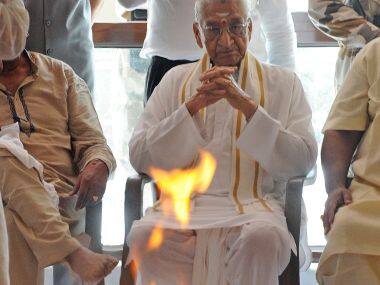Ashok Singhal was one of those pracharaks (full-timers) who were entrusted with specific tasks by the Rashtriya Swayamsevak Sangh (RSS). If Deendayal Upadhyaya, Atal Bihari Vajpayee and LK Advani were assigned to get into politics, Dattpant Thengdi to build a trade union, Singhal was given the difficult task of building a cohesive and monolithic identity of the Hindus. Singhal knew it better than most in the RSS and other constituents of the Sangh Parivar, that the division of the Hindus on caste and regional lines was so intense that it would be difficult to paper over the fault-lines. Unlike Vajpayee and Advani, he never developed a stature on his own till the Ram Janambhoomi movement got traction among people of the Hindi belt in the late eighties. Much before the BJP jumped into the Ayodhya bandwagon, Singhal kept his movement for Hindu consolidation largely apolitical. Even Congress leader, Karan Singh, participated in the Virat Hindu Sammelan organised by the VHP ostensibly to unify the community. Singhal knew it too well that unifying Hindus into a monolithic entity was an unrealistic dream. He carried the project by co-opting spiritual leaders of various sects within the Hindu fold to give a façade of unity to the religious identity. But what appears to have emboldened him is the response of people across the Hindi heartland over the issue of ‘liberation of Lord Ram’ held captive by hostile governments in Uttar Pradesh and Delhi committed to pandering to the Muslims. In the 90s, Singhal started emerging as a Hindu leader in his own right across North India and laid the foundation of the Ayodhya agitation by launching ‘Shila Pujan’ (sacred bricks for temple foundation) that captured people’s imagination. This brief history bears significance in view of the fact that Singhal’s biggest regret at the end of his life was to let the movement be hijacked by the BJP in general and LK Advani in particular for their political gains. The BJP joined the Ayodhya agitation soon after VP Singh declared implementation of the Mandal report to earmark reservation for the OBCs. In the BJP’s national executive at Palampur in Himachal Pradesh in 1989, the party committed itself to the building of the Ram temple at Ayodhya under the leadership of Advani much against the wishes of Vajpayee. Subsequently, Advani decided to embark on the Rath Yatra which led to intense politisation of the issue and ultimately the demolition of the Babri Mosque on December 6, 1992. [caption id=“attachment_2511846” align=“alignleft” width=“380”]  AFP[/caption] Singhal was far too astute to understand the dynamics of Hindu society in the wake of the Babri mosque demolition. His project of Hindu unity lay in tatters following the demolition and caste cracks opened up among the Hindus following the emergence of an alliance between the Samajwadi Party (SP) and the Bahujan Samaj Party (SP) in 1993. Realising that his ultimate objective of Hindu unity is compromised, Singhal started co-opting Dalit icons within the Sangh fold. For the first time, BR Ambedkar was included as icon in the RSS pantheon and declared as ‘prath smarniy (to be remembered in early morning)’ as a counter to the emergence of the BSP. But what people seemed to have forgotten was his novel idea of taking spiritual gurus for a community lunch hosted by the ‘Dom Raja’ of Varanasi who is the mythological figurehead of cremation ghats of the holy city. Though Dom, a caste traditionally known for cremating Hindus, belongs to untouchable section of the society, the Dom Raja is believed to be descendant of Gods. In a curious mix of mythology with the notion of Hindu resurgence, Singhal mobilised Hindu religious leaders to partake in the community meal at the house the Dom Raja. “Was it ever thinkable in the past?” he said with a sense of achievement when this correspondent once asked him the reason for this show. However, Singhal was quite aware of the fact that he had lost the credibility as leader of the Hindu masses once he let the Ayodhya agitation pass on to the hands of the BJP. “We were wrong in our assessment,” he would often say when asked if he rued the decision to let Advani hijack the temple movement. He seemed to be broken man when the Atal Bihari Vajpayee government with Advani as Home minister relegated the Ayodhya agitation to the back-burner and even threatened the VHP of serious consequence should they decide to go ahead with their plan to build the temple. But like a true pracharak of the RSS, Singhal never broke the discipline and expressed his frustration in public. More than Vajpayee, he felt “let down” by Advani with whom he eventually shunned public interaction. Though the latter tried to mend fences several times, his efforts were spurned by Singhal. Among his old time colleagues, he shared a unique bond with the founder of the BMS Dattopant Thengdi who had a similar experience with the Vajpayee-Advani duo. Singhal’s efforts at projecting Hindus as a monolithic social block may be frowned upon but cannot be undermined. His project is seen as running contrary to the principles of a secular, democratic and modern society. But there is an element of truth in the fact that he deserved to blamed less than the politicians who hijacked his project. Though he was quite soft-spoken and disciplined in his utterances, he developed the image of a rabble-rouser because of the company he kept. Till the end of his life, he remained a committed and true foot-soldier of the RSS devoted to the mission he was assigned. And he was least worried about the perception of him as a ‘hate-monger’ who is hell-bent on dividing the society on communal lines.
Ashok Singhal was one of those pracharaks (full-timers) who were entrusted with specific tasks by the Rashtriya Swayamsevak Sangh (RSS).
Advertisement
End of Article


)
)
)
)
)
)
)
)
)



